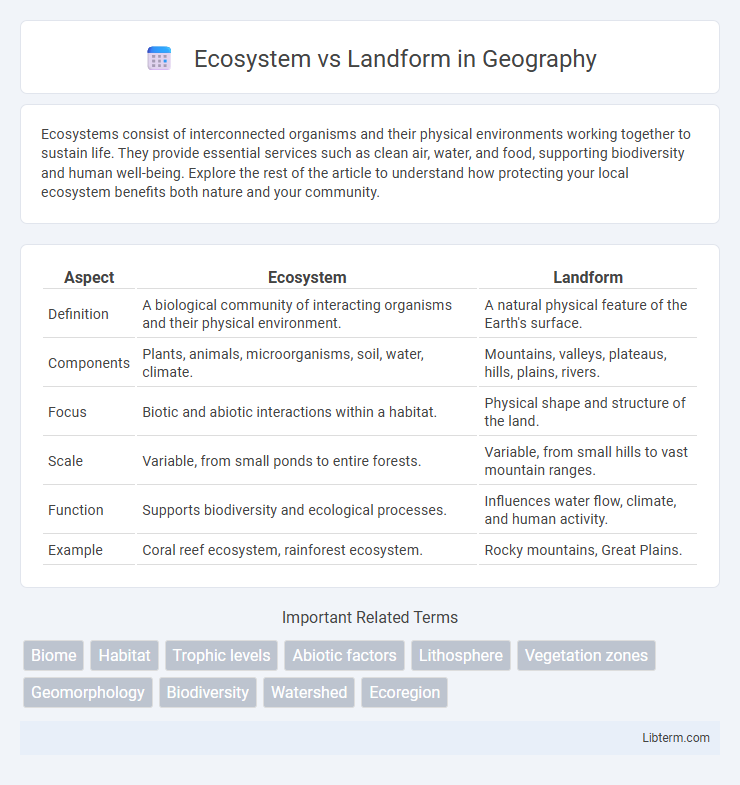Ecosystems consist of interconnected organisms and their physical environments working together to sustain life. They provide essential services such as clean air, water, and food, supporting biodiversity and human well-being. Explore the rest of the article to understand how protecting your local ecosystem benefits both nature and your community.
Table of Comparison
| Aspect | Ecosystem | Landform |
|---|---|---|
| Definition | A biological community of interacting organisms and their physical environment. | A natural physical feature of the Earth's surface. |
| Components | Plants, animals, microorganisms, soil, water, climate. | Mountains, valleys, plateaus, hills, plains, rivers. |
| Focus | Biotic and abiotic interactions within a habitat. | Physical shape and structure of the land. |
| Scale | Variable, from small ponds to entire forests. | Variable, from small hills to vast mountain ranges. |
| Function | Supports biodiversity and ecological processes. | Influences water flow, climate, and human activity. |
| Example | Coral reef ecosystem, rainforest ecosystem. | Rocky mountains, Great Plains. |
Introduction to Ecosystems and Landforms
Ecosystems consist of living organisms interacting with each other and their physical environment, forming complex networks that support biodiversity and ecological processes. Landforms are natural physical features of the Earth's surface, including mountains, valleys, plateaus, and plains, shaped by geological processes such as erosion, tectonic activity, and sedimentation. Understanding the relationship between ecosystems and landforms is crucial for studying environmental dynamics and habitat diversity.
Defining Ecosystems
Ecosystems are dynamic communities of living organisms interacting with their physical environment, encompassing biotic components like plants and animals as well as abiotic factors such as soil, water, and climate. Unlike landforms, which refer to the physical features of the Earth's surface like mountains, valleys, and plateaus, ecosystems represent functional units defined by ecological processes and energy flows. Understanding ecosystems involves analyzing biodiversity, nutrient cycles, and habitats, highlighting their role in sustaining life and maintaining environmental balance.
Understanding Landforms
Landforms are natural physical features of the Earth's surface, such as mountains, valleys, plateaus, and deserts, shaped by geological processes like erosion, volcanism, and tectonic activity. Understanding landforms involves studying their formation, distribution, and the impact of factors like climate, rock type, and human activity on their evolution. Unlike ecosystems that focus on biological communities and interactions, landforms provide the foundational physical context influencing ecosystem development and biodiversity patterns.
Key Differences between Ecosystems and Landforms
Ecosystems consist of living organisms interacting with each other and their physical environment, encompassing biotic and abiotic components such as plants, animals, soil, and climate. Landforms refer to the natural physical features on Earth's surface, including mountains, valleys, plateaus, and plains, shaped by geological processes like erosion, tectonic activity, and sedimentation. The key difference lies in ecosystems representing dynamic biological communities and processes, while landforms denote static geological structures without direct consideration of living organisms.
How Ecosystems Interact with Landforms
Ecosystems interact with landforms by shaping and being shaped by the physical features such as mountains, valleys, and plains that influence water flow, soil composition, and microclimates critical for biodiversity. Landforms determine the distribution of habitats and species by creating distinct environmental gradients that affect temperature, moisture, and nutrient availability. This dynamic relationship results in unique ecological communities adapted to specific terrain characteristics, driving processes like erosion control, nutrient cycling, and habitat connectivity.
Types of Ecosystems Found in Various Landforms
Types of ecosystems vary significantly across different landforms, shaping unique environmental characteristics and biodiversity. Mountain landforms often support alpine and montane ecosystems, characterized by cold temperatures and specialized flora and fauna, while desert landforms host xeric ecosystems adapted to arid conditions with drought-resistant plants and animals. Coastal landforms feature marine and estuarine ecosystems, rich in aquatic biodiversity and complex nutrient cycles, contrasting with forest ecosystems found in plains or plateau landforms, which sustain dense vegetation and diverse terrestrial wildlife.
The Role of Climate in Shaping Ecosystems and Landforms
Climate significantly influences both ecosystems and landforms by determining temperature, precipitation patterns, and weather events that shape biological communities and physical terrain. Variations in climate drive soil formation, vegetation types, and erosion processes, leading to distinct landforms such as deserts, mountains, and wetlands. Ecosystems adapt to these climate-driven landforms, creating interconnected environments where flora and fauna evolve based on climate-induced conditions.
Human Impact on Ecosystems and Landforms
Human activities significantly alter ecosystems through deforestation, pollution, and urbanization, disrupting biodiversity and ecological balance. Landforms are reshaped by mining, construction, and agriculture, causing erosion, sedimentation, and habitat loss. The cumulative impact of human interventions leads to degraded ecosystems and modified landforms, affecting natural processes and sustainability.
Importance of Preserving Both Ecosystems and Landforms
Preserving ecosystems and landforms is crucial for maintaining biodiversity, supporting wildlife habitats, and ensuring natural resource availability vital for human survival. Healthy ecosystems regulate climate, prevent soil erosion, and filter water, while intact landforms provide geological stability and cultural value. Protecting both fosters resilience against environmental changes and sustains ecosystem services essential for future generations.
Conclusion: Harmonizing Ecosystem and Landform Conservation
Harmonizing ecosystem and landform conservation is essential for sustaining biodiversity and geological integrity. Integrating ecological processes with physical landscape features promotes resilience against environmental changes and supports habitat connectivity. Effective management strategies must balance preserving biological diversity and maintaining landform stability to ensure long-term environmental sustainability.
Ecosystem Infographic

 libterm.com
libterm.com